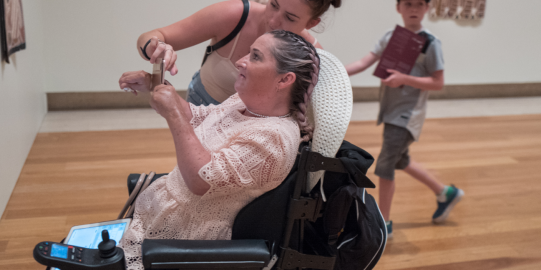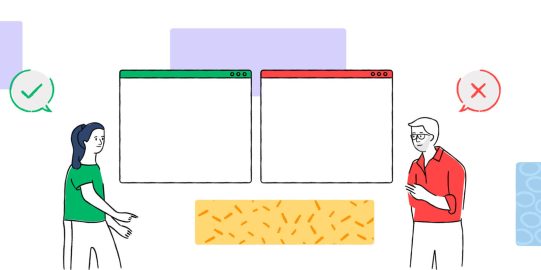Daniel uses minimal speech. Before he had a specific personal Augmentative and Alternative Communication (AAC) system, he preferred to write notes to communicate. Once he got a cellphone, he began texting, often with people in the same room. Now, he finds that his AAC is more easily understood by more people: he can show a large screen with his typed message, and the digital voice speaks it aloud. He says that his AAC is basically instant messaging, just in the same room as the other person. He jokes that his vast collection of t-shirts is a form of AAC because the messages and images tell the world what is important to him.
The American Speech-Language Hearing Association (ASHA) defines AAC very broadly: “AAC includes all of the ways we share our ideas and feelings without talking.” By that definition, every person is an AAC user but only some people can rely on speech.
AAC users are at an automatic disadvantage in a world that often prefers spoken language. People who can not rely on speech require support and accommodation to access communication. We can do this by encouraging them to use whichever form of communication they find the most accessible, that most other people can understand.
Multimodal communicators
Gestures, vocalizations, facial expressions, manual sign language, letterboards, photos, social media, formal AAC systems (including speech generating devices and light-tech or paper-based communication books)and typed or hand-written language: these are all modes of communication. Anyone who uses more than one of these strategies is a multimodal communicator.
Each of us has strategies to decide which mode of communication is the most appropriate at any given time. We nod our heads and make sympathetic sounds while listening to someone complain. We gesture at the serving platter and a companion passes it. We respond to a text message by texting back. Maybe we decide that a longer response is called for, and we telephone or email. We might even text our family members from within the same house! We post a baby photo on social media with only a short text caption but write a longer message by email when sharing the story with grandparents.
For most of us who can speak, speech is our most effortless mode of communication. We need to consider the difficulties in terms of access and use for the different ways to communicate.
Face-to-face conversation
Each AAC user may have different experiences with face-to-face conversations. Face-to-face communication is typically fast-paced. Conversations are often brief. Each communication partner is expected to process the other's speech, gestures, and facial expressions almost instantly, with a response expected within a fraction of a second. This rapid pace is often a barrier to nonspeaking people because alternatives to speech are all slower to produce. Many AAC users report that this timing barrier means they are perceived as more impaired, and therefore more likely to be ignored or disrespected.
However, some AAC users prefer face-to-face communication.
“Face to face is always better because you get the sense of someone’s mood and facial expressions and demeanor that you would not have in online text-based communication” ~ Lisa Lehmann, AAC user
Interestingly, many AAC users reported that face-to-face conversations with other AAC users are more equitable and enjoyable than conversations with speaking people. This suggests that the fast pace of spoken language and the rapid rate of turn transfers is the greatest barrier.
Face-to-face conversation also requires both people to be in the same space, where background noise and other aspects of the physical space itself increase the demands on the AAC user. Given these demands, many AAC users struggle with face-to-face communication without the support of good communication partners.
Research shows that speech-language pathologists (and most speaking people) prefer verbal speech and encourage AAC users to communicate in a way that is easiest for us. Learning to include people with a communication disability requires speaking people to select strategies that are more accessible to AAC users.
Other forms of communication
Let’s consider the demands and access concerns of other forms of communication. Then we can think about how each form can be used equitably and effectively by an AAC user.
Facial expressions
Many AAC users are gifted at using their facial expressions as engaged listeners. Others do not have easy control of facial expressions or may make involuntary movements or sounds that can be misinterpreted. While using AAC, facial expressions need to be timed with a message that may have been constructed minutes earlier, rather than simultaneous and spontaneous with speech. Some AAC users report that processing another person’s facial expressions slows their ability to process spoken language; they find written text more accessible than speech.
Manual sign language and gestures
Many gestures are convenient and widely familiar to most people, especially when communicating about concrete items in the same room, such as gesturing for someone to pass you an item. But simple gestures can be difficult to interpret if the idea is more abstract. Manual sign language solves this problem: a formally signed problem is fast, efficient and can convey all the same meaning as speech. However, the limitation of sign language is that it is only understandable if both communication partners understand it. Some AAC users have motor difficulties that limit their ability to form manual signs.
“Choice in communication is huge. I don't solely use my device to communicate, at least with my family: Sometimes I vocalize (often for yes-no questions), or point, or give thumbs up or thumbs down. A new one has been, when given multiple options, holding up a number of fingers for which option I prefer, which has been helpful when out walking without ready access to my phone or iPad.”
~ Darla Burrow, AAC user
Telephone
Talking on the telephone is usually more difficult than face-to-face communication for AAC users. Phone calls are often short and fast-paced. Manual sign language, facial expressions, and gestures are not visible. Many AAC users report frustration integrating their assistive technology with phone-based technology. Some said that unfamiliar people assume it is a prank call and hang up when they hear the digital voice.
Video calls
FaceTime, Skype, and other forms of video-based calling have soared in popularity with speaking people. Interestingly, many AAC users report that they greatly enjoy video calls, often with other AAC users. Many suggested that their AAC technology is more compatible with various video-based calling platforms than with traditional phones. Many AAC users also use sign language, which is visible on a video call. Video calls with speaking people may not be more accessible than face-to-face if the fast pace and timing barriers still exist.
Handwriting
Handwriting can be an effective backup method for many AAC users. Writing a note in lieu of speech is common and often convenient. Writing tools are readily available in most contexts and the format is familiar to most people. However, the average adult can write only about 15 legible words per minute. Some AAC users have motor challenges that make handwriting difficult. Handwriting, therefore, shares many of the limitations of other forms of AAC when used in face-to-face conversation. It also limits the AAC user to communicating with literate partners in the same physical room.
Writing or typing
Writing and typing during a live conversation with a person who is speaking is more demanding. But writing and typing work equally well for all parties when writing letters, instant messaging, or sending emails. Some AAC users report that written or typed messages are more accessible in conversation when both parties are using the same medium, such as both texting to each other. As one AAC user said, “it slows the pace and levels the playing field.” Many AAC users find that written or digital forms of communication prevent them from being judged on their physical appearance or the speed of their message construction.
“Text communication 1) eliminates the need for interpreting and displaying normative nonverbal cues, 2) can be completely isolated from auditory stimuli and background noise that may be distressing or make it difficult to understand spoken words, 3) can connect me with other autistics more easily since we are a bigger group as a percentage of the world compared to just the percentage in my hometown, 4) THEIR words are coming visually as well, and possibly on no implied timeline in terms of needing to respond right away, so i have much more ability to process what they're saying and formulate my thoughts better than in offline communication.” ~ endever* corbin, AAC user
Email as a form of communication is uniquely accessible to many AAC users. It is commonly accepted for people to take hours, or even days, to respond to an email. This permits AAC users to take their time constructing a message and to proof-read it at their leisure. Many AAC users feel they are better understood when they have more time to construct messages, to edit or proofread, and to ensure their message accurately reflects their intention. Turn-taking is far less rapid, so removes some of the time pressure of responding.
Instant messaging
Instant messaging is a faster communication medium than email, but slower paced than face-to-face communication. Both communication partners type their response, leveling the playing field for the AAC user. Instant messaging is forgiving of typos, spelling errors, and grammar mistakes, making it a friendly medium for AAC users who struggle with accuracy on a keyboard or are still developing their spelling skills. Most platforms also allow easy use of emojis, an efficient way to express entertaining and whimsical expressions.



